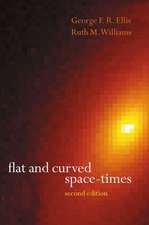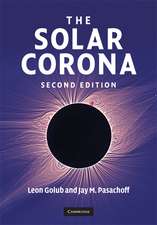The Early Universe with the VLT: Proceedings of the ESO Workshop Held at Garching, Germany, 1–4 April 1996: ESO Astrophysics Symposia
Editat de Jacqueline Bergeronen Limba Engleză Paperback – 20 noi 2013
Din seria ESO Astrophysics Symposia
- 15%
 Preț: 656.43 lei
Preț: 656.43 lei - 15%
 Preț: 656.10 lei
Preț: 656.10 lei -
 Preț: 369.78 lei
Preț: 369.78 lei -
 Preț: 404.51 lei
Preț: 404.51 lei - 15%
 Preț: 644.95 lei
Preț: 644.95 lei - 15%
 Preț: 656.43 lei
Preț: 656.43 lei -
 Preț: 391.97 lei
Preț: 391.97 lei - 18%
 Preț: 971.01 lei
Preț: 971.01 lei -
 Preț: 434.94 lei
Preț: 434.94 lei - 15%
 Preț: 650.86 lei
Preț: 650.86 lei -
 Preț: 402.98 lei
Preț: 402.98 lei -
 Preț: 403.90 lei
Preț: 403.90 lei -
 Preț: 412.78 lei
Preț: 412.78 lei - 15%
 Preț: 645.47 lei
Preț: 645.47 lei -
 Preț: 431.30 lei
Preț: 431.30 lei - 15%
 Preț: 649.06 lei
Preț: 649.06 lei -
 Preț: 402.56 lei
Preț: 402.56 lei - 15%
 Preț: 647.27 lei
Preț: 647.27 lei -
 Preț: 413.15 lei
Preț: 413.15 lei -
 Preț: 409.30 lei
Preț: 409.30 lei -
 Preț: 430.10 lei
Preț: 430.10 lei -
 Preț: 406.42 lei
Preț: 406.42 lei - 15%
 Preț: 658.05 lei
Preț: 658.05 lei - 20%
 Preț: 590.38 lei
Preț: 590.38 lei -
 Preț: 400.65 lei
Preț: 400.65 lei -
 Preț: 413.15 lei
Preț: 413.15 lei - 15%
 Preț: 658.70 lei
Preț: 658.70 lei -
 Preț: 401.79 lei
Preț: 401.79 lei -
 Preț: 436.70 lei
Preț: 436.70 lei -
 Preț: 404.13 lei
Preț: 404.13 lei
Preț: 397.76 lei
Nou
Puncte Express: 597
Preț estimativ în valută:
76.12€ • 79.18$ • 62.84£
76.12€ • 79.18$ • 62.84£
Carte tipărită la comandă
Livrare economică 15-29 aprilie
Preluare comenzi: 021 569.72.76
Specificații
ISBN-13: 9783662224885
ISBN-10: 3662224887
Pagini: 464
Ilustrații: XXII, 441 p. 227 illus., 14 illus. in color.
Dimensiuni: 155 x 235 x 24 mm
Greutate: 0.64 kg
Ediția:Softcover reprint of the original 1st ed. 1997
Editura: Springer Berlin, Heidelberg
Colecția Springer
Seria ESO Astrophysics Symposia
Locul publicării:Berlin, Heidelberg, Germany
ISBN-10: 3662224887
Pagini: 464
Ilustrații: XXII, 441 p. 227 illus., 14 illus. in color.
Dimensiuni: 155 x 235 x 24 mm
Greutate: 0.64 kg
Ediția:Softcover reprint of the original 1st ed. 1997
Editura: Springer Berlin, Heidelberg
Colecția Springer
Seria ESO Astrophysics Symposia
Locul publicării:Berlin, Heidelberg, Germany
Public țintă
ResearchCuprins
Cosmological Questions for the European Southern Observatory Very Large Telescope.- The VLT First Generation Instrument Capabilities as Cosmological Tools.- ISAAC — IR Spectrometer and Array Camera.- Observing the Early Universe with CONICA.- Spectroscopy of Faint Distant Objects with FORS.- FUEGOS: Multi-Objects and 2-D Spectrograph for the VLT.- The ESO UV-Visual Echelle Spectrograph (UVES).- Galaxy Evolution at z ? 1.- Evolution of Normal Galaxies: HST Morphologies and Deep Spectroscopy.- The Canada France Redshift Survey.- Galaxy Evolution: Luminosities and Linewidths.- Distant Supernovae and Cosmic Deceleration.- Evolution of Elliptical Galaxies up to z ? 1.- Constraining the Evolution of Galaxy Masses and the M/L Ratios out to z=1.- 2D Spectroscopy of Remote Radiogalaxies with TIGER.- Spectro-Imaging of Starburst Galaxies: Present and Future.- Search for Highest Redshift Galaxies.- Keck Spectroscopy of Redshift z ~ 1 Field Galaxies.- VIRMOS: Deep Redshift Surveys with the VLT.- The AUSTRALIS Instrument Concept — an Interim Report.- Numerical Simulations of Galaxy Formation.- The Calar Alto Deep Imaging Survey for Primeval Galaxies.- Faint Emission Line Galaxies Detected in CADIS.- A Global Approach to Star and Galaxy Formation.- Metal Absorption from Galaxies in the Process of Formation.- Weak Lensing at the Limit of the Sky Background Noise.- Morphology of High Redshift Galaxies with HST.- Search for Galaxies at z > 4 from a Deep Multicolor Survey.- Clusters and Large-Scale Structure.- Large-Scale Structure at High Redshift.- The CNOC Cluster Survey.- Clusters of Galaxies and the VLT.- Visible Multi-Object Spectroscopy: Prospects and Requirements.- Dark Matter Searches with Weak Gravitational Lensing.- Large-Scale Structure at High Redshift.- Clusteringof Absorption Line Systems.- Searches for High Redshift Clusters.- First Active Objects.- High Redshift Radio Galaxies with the VLT.- Keck Spectropolarimetry of High z Radio Galaxies: Discerning the Components of the Alignment Effect.- The Importance of IR Polarimetry for the Study of High Redshift Galaxies.- Quasar Surveys.- Starburst Galaxies at High Redshift.- Prospects for ISO Deep Surveys.- Optical Searches for Quasars with z > 5.- Dust and the Search for High Redshift Quasars.- Radio-Selected High Redshift Quasars.- Millimetre Emission from High Redshift Radioquiet Quasars.- Can Photoionization Solve the Overcooling Problem? A Quick Look at the Cosmological History of Baryons.- Concluding Remarks.- Which Second Generation VLT Instrumentation?.- Poster Papers.- Galaxy Evolution at Low Redshift? Inferences from Optical and IR Counts.- Novae as Distance Indicators: Simulation of VLT Observations of Fornax.- The Search for Clustering at z > 0.8.- Emission-Line Profile Studies of QSOs at z ? 3.- Redshift and Photometric Survey of the X-ray Cluster of Galaxies Abell 85.- CFRS: The Minimal Ages for Starburst Galaxies.- Object Detection and Classification in CADIS.- Simulations of High Redshift Galaxies Colors at the NTT-SUSI2 and VLT-FORS.- Spectral Classification of Galaxies with z ? 0.5.- The Galaxy Environment of QSOs as a Function of Redshift.- Detailed Kinematics of Extended Lyman-? Regions Around Radio Galaxies at z > 2.- AGN Host Galaxies at Intermediate Redshift.- Void Hierarchy — a Guiding Principle to the Study of Faint Structures in Voids.- Implications for Optical Identifications of QSO Absorption Systems from Galaxy Evolution Models.- The Extended Luminosity Function in Clusters of Galaxies: a Tool to Search for Environmental Effects.- A HighRedshift Line Emitting Object Discovered in the Near Infrared.- Looking for High Redshift Forming Galaxies in the Near Infrared.- Neoclassic Cosmological Tests with QSOs.- Chemical Evolution at High Redshift.- Measurement of q 0 with Type Ia Supernovae.- Spectrophotometric Investigations of Blue Compact Dwarf Galaxies with the VLT.- A Deep 20 cm Radio Mosaic of the ESP Galaxy Redshift Survey.- A New Model of Spectral Evolution: PEGASE Application to Galaxy Counts.- An H? Search for Star Forming Galaxies at z=1.5.- RXJ1347–1145: a Galaxy Cluster with Exceptional Properties.- A Survey for H? Emission at z = 2.2 – 2.4.- Neutral Nitrogen in Damped Lyman a Systems.- Colours, Luminosity Functions, and Clustering Properties of Faint Starburst Galaxies.- Large-Scale Structure at z ~ 3.
Textul de pe ultima copertă
This workshop is dedicated to research projects on the early universe, discussing strategies for studying faint distant objects in the optical and infrared spectral regions. This field is evolving very rapidly. Observational constraints on the evolution and formation of galaxies and large-scale structures as well as the cosmic chemical evolution were critically discussed with regard to theory and numerical simulations. In this context, the VLT first-generation instrument capabilities were presented comprehensively and their use as cosmological tools discussed. The concluding remarks focussed on the analysis of various possibilities for the VLT second-generation instrumentation. Many of these topics were covered by invited reviews and talks, as well as contributed talks. They are included in this volume together with the poster papers.














